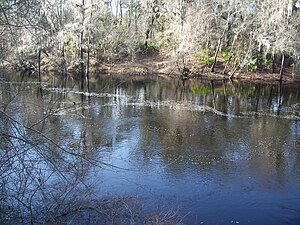
It' been another busy week for us here at Kelly's RV Park in White Springs, FL. The weather has finally cooled down enough to drastically reduce our need for air conditioning, which is a nice change after the past four months of unending heat. The only we really need is rain. The Suwanee River is now running so low that small islands, which are normally submerged under six feet of water, can now be seen in the middle of the stream.
Over the past few days, Deb has helped with getting the clubhouse kitchen reorganized after its painting and floor resurfacing and, this morning, also helped out at the monthly pancake breakfast. In addition to my daily writing assignments, I have also been helping the owners install a new WiFi system. For two people who are supposedly semi-retired, we've been putting in a lot of time actually working. We're not complaining though, because it feels good to be involved with the projects and the people here at the park.That's one of the advantages of extended stays in a full-time RV lifestyle.
After spending three hours on the phone yesterday with several technicians of the Cisco corporation, I'm glad I decided to not make installing wireless systems a career. I know a lot about computers and have installed several wireless systems, but the tedium of fine turning the programming bugs in the system being installed here tested my patience. Part of the frustration was trying to talk to technicians that had heavy foreign accents and seemed confused about even the basic steps needed to correct a problem with a product their company manufactured. I beg you major corporations, please provide easy to understand and knowledgeable technicians. No one should require a translator when trying to solve a technical problem.
The system still has a few bugs to correct, but once everything is operating properly Kelly's will have the best WiFi system available in the area. In order to stay competitive, any RV park today must have a reliable wireless system that people can access from inside their units.That's no small task in a large area that is packed with metal-sided structures, but without wireless access people will quickly stay at another park that does provide it.There is just too much of modern life that now revolves around the Internet.
We're looking forward to a relaxing weekend and slowing down for a few days. Let's just hope there is no need for a translator in the near future.
Until next time, Happy Trails everyone.
Copyright 2009-2010 Lane A Geyer
Photos by Debbie













